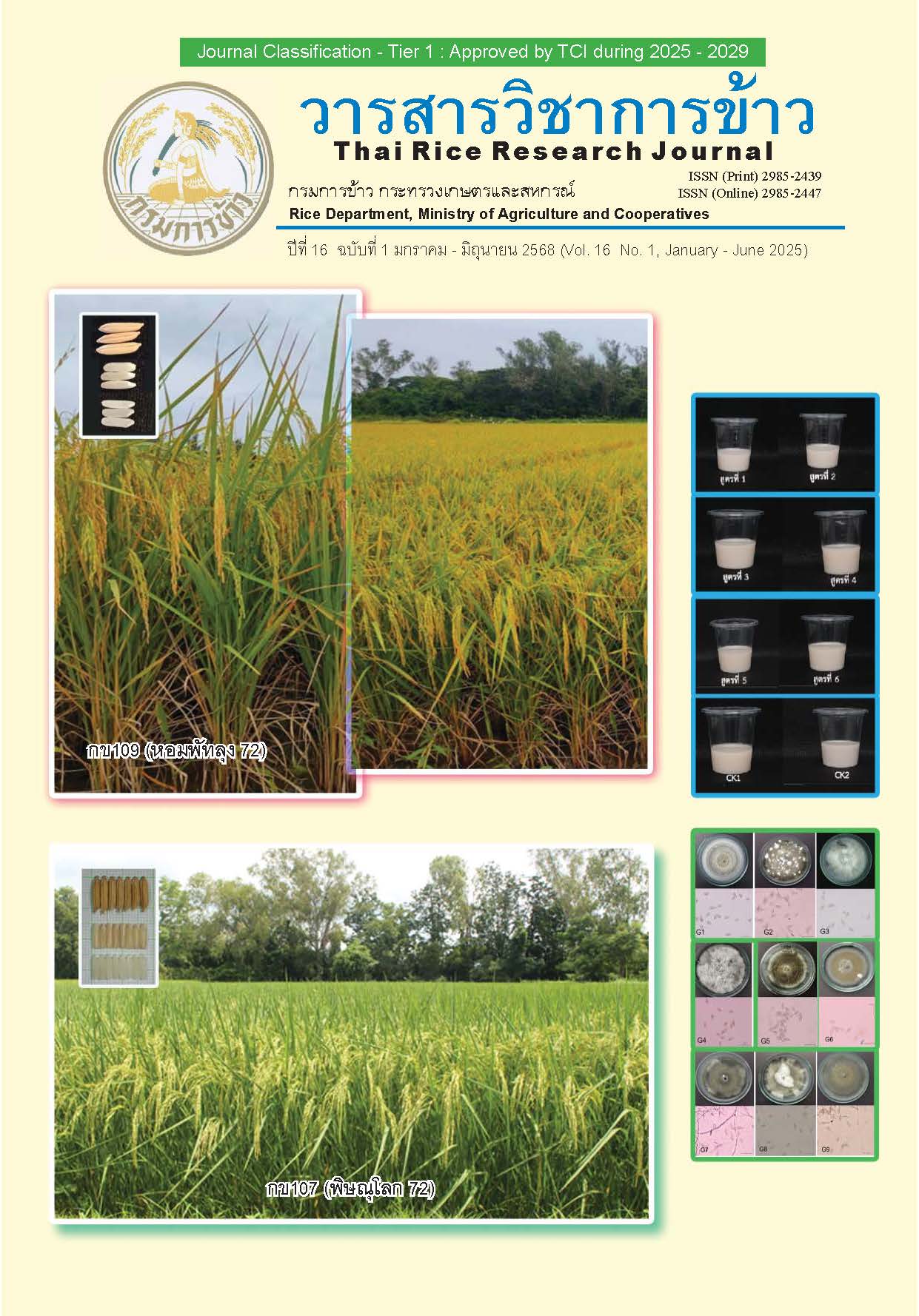RD107 (Phitsanulok 72), a Non-glutinous Rice Variety
Main Article Content
Abstract
Thailand has exported hard-textured rice to Africa, the Middle East, and Asia in terms of parboiled and white rice at about 1.5 million tons in 2023. Although this type of Thai rice is a large portion of the international market, it is confronted with several challenges, including production problems, lowering the price, and increasing production from overseas competitors. Thus, the distinction of Thai rice from the others should be recognized, especially the fragrant rice with a hard texture, which could be directly used and processed. In addition, the non-photosensitive rice varieties with hard texture and aroma are limited, though the release of variety Chai Nat 2 is due to its low yield. The Thai Rice Department, led by the Phitsanulok Rice Research Center (PSL), developed a new fragrant rice variety, RD107 (Phitsanulok 72), that could be an alternative option for farmers to grow in both wet and dry seasons. This variety was renamed from the line PSL16348-MAS-293-3-1-2-1, which was an outstanding line from the single cross made at PSL in 2016 between PSL15082-MAS-12-362 with the bacterial blight-resistant gene (xa5) and PSL15456-MAS-1 with genes resistant to brown planthopper (Bph3), aroma (badh2), and submergent tolerance (Sub1). This line had been under selections of progenies through molecular markers followed by observations and the varietal improvement processes of yield trials as well as evaluating the resistance to major diseases and insect pests, nitrogen response, physical and chemical properties of grain, milling, and cooking quality together with the acceptance of stakeholders during 2017-2023. The Thailand Rice Variety Board agreed to release it in the name of RD107 (Phitsanulok 72) for the celebrations on the auspicious occasion of His Majesty the King’s 6th Cycle Birthday in 2024. It is a non-glutinous variety with a hard texture, aromatic and non-photosensitive, with a maturity from planting of approximately 108 days (transplanting) and 89-100 days (germinated seed broadcasting). This variety has an average height of 102 cm with erect culm and stiff stem, shattering, straw color paddy (11.0 mm length, 2.56 mm width, 2.02 mm thick) with awn. The length of brown rice is 8.03 mm, 2.17 mm in width, and 1.87 mm thick, considered a slender shape. The average yield was 674 kg/rai (approximately a potential yield at 1,070 kg/rai) with a good milling quality (total whole kernel and head rice of 48.00%). Seed dormancy of this variety is three weeks. It has a crumbly cooking quality, a hard texture with a high amylose content of 26.61%, and an aromatic quality of 0.61 ppm 2AP concentration. It can be qualified as premium-grade rice (100%) of export quality for non-glutinous, fragrant, and hard-textured white rice. In addition, it is moderately resistant to brown planthopper and moderately tolerant to flash flooding but susceptible to blast, bacterial blight, and whitebacked planthopper. It is suitable for planting in irrigated rice production systems in central and lower northern Thailand.
Article Details
References
กรมการข้าว. 2566. แผนปฏิบัติงานแผนการผลิตและการตลาดข้าวครบวงจร ปีการผลิต 2566/67. กรมการข้าว, กระทรวงเกษตรและสหกรณ์. 100 หน้า.
กรมส่งเสริมการเกษตร. 2563. ข้อมูลผู้ประสบภัยพิบัติด้านพืช (ข้าว) ปี 2559-2563. 1 หน้า.
วันทนา ศรีรัตนศักดิ์, สุกัญญา อรัญมิตร และจินตนา ไชยวงค์. 2554. สถานการณ์ระบาดของเพลี้ยกระโดดสีน้ำตาลในประเทศไทย. หน้า 209-225. ใน: การประชุมวิชาการข้าวและธัญพืชเมืองหนาว เนื่องในโอกาสวันข้าวและชาวนาแห่งชาติ ครั้งที่ 2 ปี 2554 “เฉลิมพระเกียรติ 84 พรรษา ด้วยงานวิจัยข้าวไทย” . โรงแรมอมารี แอร์พอร์ต ดอนเมือง, กรุงเทพฯ.
ศูนย์วิจัยข้าวชัยนาท. 2564ก. เอกสารประกอบการประชุมการเปรียบเทียบผลผลิตข้าวนาชลประทานในเขตภาคเหนือตอนล่าง ฤดูนาปี 2563. 10 มิถุนายน 2564. ศูนย์วิจัยข้าวชัยนาท, จ.ชัยนาท. 95 หน้า.
_______________. 2564ข. เอกสารประกอบการประชุมการเปรียบเทียบผลผลิตข้าวนาชลประทานในเขตภาคเหนือตอนล่าง ฤดูนาปรัง 2564-ฤดูนาปี 2564. 28 ธันวาคม 2564. ศูนย์วิจัยข้าวชัยนาท, จ.ชัยนาท. 102 หน้า.
สำนักงานเศรษฐกิจการเกษตร. 2566. สถิติการค้าสินค้าเกษตรไทยกับต่างประเทศ ปี 2565. ศูนย์สารสนเทศการเกษตร, สำนักงานเศรษฐกิจการเกษตร. 180 หน้า.
สำนักงานส่งเสริมการค้าในต่างประเทศ. 2562. “กลิ่นหอมของข้าวไทย” จุดแข็งวัตถุดิบผลิตเหล้า Awamori. กรมส่งเสริมการค้าระหว่างประเทศ, กระทรวงพาณิชย์. 2 หน้า.
สำนักงานส่งเสริมการค้าในต่างประเทศ. 2564. ภาพรวมตลาดข้าวในอาเซียน. กระทรวงพาณิชย์. 4 หน้า.
Heinrichs, E.A., F.G. Medrano and H.R. Rapusus. 1985.Genetic Evaluation for Insect Resistance in Rice. International Rice Research Institute, Los Baños, Philippines. 352 p.
IRRI. 2014. Standard Evaluation System for Rice (SES). International Rice Research Institute, Los Baños, Philippines. 57 p.
Ismail, A.M., U.S. Singh, S. Singh, M.H. Dar and D.J. Mackill. 2013. The contribution of submergence-tolerant (Sub1) rice varieties to food security in flood-prone rainfed lowland areas in Asia. Field Crops Research 152: 83-93.
